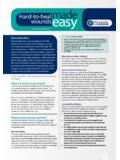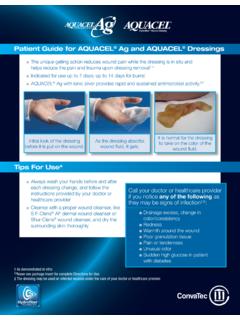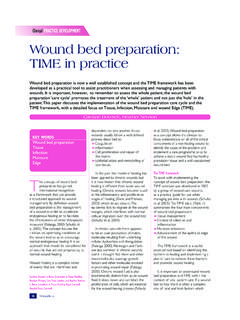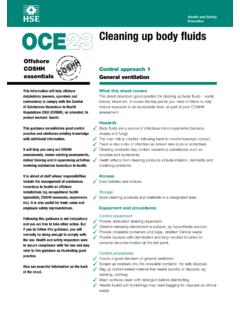Transcription of Principles of skin and wound care: the palliative …
1 Jane McManus is Deputy Ward Manager, Rugby Ward, St Christopher s Hospice, London. Email: goals of palliative wound care include reducing pain, odour, exudate, bleeding and infection (McDonald and Lesage, 2006). Some authors have raised concerns with regard to the use of the term palliative wound care as patients might be labelled palliative if their wounds are too difficult or costly to heal, allowing palliative to excuse poor outcomes (Ennis and Meneses, 2005). It is important that patient comfort takes priority over preventing skin breakdown and care of the wound in palliative care (Langemo, 2006).
2 However, when wounds and their symptoms worsen following implementation of measures designed to prioritise patient comfort, holding these opposing needs in balance becomes more challenging for clinicians and patients. This article will argue that current theories of moist wound management, with healing as the endpoint, are inappropriate for the needs of palliative patients with wounds (Grocott, 2005). It will also describe the Principles of wound management and symptom control with regard to wounds commonly found in patients in the advanced stages of their disease.
3 wound typesA wound is a breach in the epidermis or dermis resulting from trauma or pathological change that initiates a process of repair (Collins et al, 2002). An acute wound is a wound that occurs suddenly and has a short duration. Examples include surgical wounds and burns that heal easily with few complications (Dealey, 1999). A chronic wound is a wound that remains unhealed for longer than 6 weeks, influenced by complex and multiple factors that impede healing (Collins et al, 2002). In chronic wounds, the pattern and timing of physiological and biochemical changes associated with healing are disrupted.
4 Although chronic wounds have been defined as those that do not heal , and have been interpreted as the result of deficiencies in diagnosis or management, some chronic wounds appear resistant to all treatments aimed at them (Enoch and Price, 2004). Patients unable to eat a balanced diet or to digest and absorb nutrients, will be less likely to have a wound that heals and remains healed. Examples of commonly occurring chronic wounds in palliative care include pressure ulcers and fungating or malignant ulcersA pressure ulcer is an area of local necrosis developing when soft tissue is compressed between a bony prominence and a rigid external surface (McGrath and Breathnach, 2004).
5 The mean capillary blood pressure in the skin of healthy individuals is 25 30mmHg. Damage to the subcutaneous tissue can occur after both prolonged exertion of pressure and shorter periods of high pressure (Langemo, 2006; Langemo and Brown, 2006).Any severely ill patient may develop pressure ulcers. Immobility and prolonged pressure on a body part is the major risk factor, although reduced sensory perception, older age and neurological disability are also Principles of skin and wound care: the palliative approach CLINICAL SKILLSJane McManus8 End of Life Care, 2007, Vol 1, No 1 KEY WORDSC hronic woundsDry wound management Moist wound managementPalliative wound careThe term palliative care is used to describe care given to patients with advanced, life-limiting illness of any aetiology.
6 It is a philosophy of care that is patient and family-centred, designed to meet the needs of the patient and family. wound care for palliative care patients should be managed so that patient and family needs/concerns are the main focus of attention. Dressing products designed to heal acute wounds may not have the same effect on chronic, non-healing wounds. The palliative care goals of symptom control and psychosocial support can be transferred to palliative wound care for patients whose wounds will not heal.
7 Nurses must become familiar with the concept of a stable non-healing wound when providing palliative wound care. This article will discuss the Principles of wound management in relation to palliative care. Declaration of interests: care 812/3/07 14:08:26develop at the site of the primary cancer and also at affected lymph nodes of the axilla and groin (Dealey, 1999). A malignant wound is unlikely to improve, even if radiotherapy, chemotherapy or surgery offer short-term symptom reduction, because cancer cells continue to grow (Figure 2).
8 Bridel-Nixon (1997) notes that there is a dearth of published research on fungating wounds. Most articles discuss single cases. The UK incidence and prevalence is difficult to determine, as national cancer registries do not record this information (Thames Cancer Registry, 2005). Few published studies discuss the extent of the problem (Bridel-Nixon, 1997). The incidence of malignant wounds in patients with breast cancer appears to be between 2 and 5% (Fairbairn, 1993; Haisfield-Wolfe and Rund, 1997; Grocott, 1999).
9 A 10-year prevalence study at a cancer registry in the USA revealed that 367 (5%) of 7316 patients had cutaneous malignancies, of which 38 had wounds resulting from direct local invasion, 337 had metastatic wounds, and eight had both (Lookingbill et al, 1990). Malignant wounds affect a small group of people but provide major challenges that will be factors (Reifsnyder and Magee, 2005) (Figure 1). Dehydration and hypotension compound tissue damage. Further risk factors include general ill health, ischaemic heart disease, peripheral vascular disease, raised body temperature, incontinence and poor nutritional state, especially hypoalbuminaemia and low vitamin and zinc levels (Dealey, 1999).
10 Drugs that suppress sensation, mobility or blood flow and skin strength are also aggravating factors (McGrath and Breathnach, 2004), steroids (Dealey, 1999) and vasoactive drugs often used in cardiac care (Papantonio et al, 1994). The occurrence of pressure ulcers varies according to patient group and care setting. One study of patients receiving home hospice care in the USA highlighted increased incidence of pressure ulcers in patients who had a history of pressure ulcers, were older, had a diagnosis of cancer, central nervous system disorders or dementia and had lower Karnofsky palliative performance scores (Reifsnyder and Magee, 2005).








